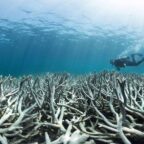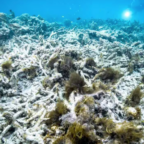
The Great Barrier Reef is experiencing its most widespread coral bleaching event, according to scientists who say record warm temperatures and warming oceans are threatening its fragile corals. The entire Great Barrier Reef and some of its surrounding areas are facing an unprecedented period of heat stress in what is the third major bleaching event in only the past five years. Heat-induced bleaching can occur periodically, but scientists say climate change is causing the destructive events to happen more frequently, which is particularly troubling because corals don’t have enough time to recover and grow back.
The reef’s last major bleaching event occurred in 2017, and scientists weren’t expecting another one so soon, said Mark Eakin, coordinator of the National Oceanic and Atmospheric Administration’s Coral Reef Watch program in College Park, Maryland.
“This has never happened before,” Eakin said. “We’re in completely uncharted territory.”
There have been only five recorded bleaching events at the Great Barrier Reef, said Terry Hughes, director of the Australian Research Council’s Centre of Excellence for Coral Reef Studies at James Cook University in North Queensland. The first occurred in 1998, followed by another in 2002. There was then a 14-year gap before the next one, in 2016, but then the first instance of back-to-back bleaching events occurred the following year.
“The gap between one event and the next is shrinking, not just for the Great Barrier Reef, but reefs throughout the tropics,” Hughes said. “That’s important, because it takes a decade or so for a half-decent recovery of even the fastest-growing corals. The slowest ones take several decades.”
Coral bleaching occurs as a response to abnormal conditions, such as when ocean temperatures are cooler or warmer than usual or when ocean water is more acidic than normal. These environmental stressors cause corals to expel tiny photosynthetic algae that live in their tissues, causing the colorful and vibrant marine invertebrates to turn ghostly white.
The bleaching process doesn’t necessarily kill the corals, but the reefs are subsequently more susceptible to disease.
In the 2016 bleaching event, 27 percent of the Great Barrier Reef’s corals died, and the following year, 22 percent were lost, meaning nearly half the famed reef’s corals died in just two years.
Hughes said early satellite observations suggest that this year’s bleaching is far more widespread across the reef compared to 2016 and 2017 but not as severe.
But the extent of the damage will also depend on how much ocean temperatures warm over the coming weeks and for how long. Past bleaching events, such as those in 2002 and 2016, have been driven by El Niño conditions, which are naturally occurring climate patterns that affect the equatorial Pacific and can trigger far-reaching climate anomalies.
The current bleaching event is happening even in the absence of El Niño conditions, according to Eakin.
“We no longer need an El Niño to trigger a bleaching event — we just need a hot summer,” he said. “And the summers are getting hotter and hotter because of global warming. That is astounding in itself.”
Maintaining the health of the Great Barrier Reef carries enormous economic implications — the area, a designated World Heritage Site, has been valued at more than $50 billion — but the sprawling reef is also an important part of the ocean ecosystem. The reef, which covers an area almost 1,500 miles long off the coast of Queensland, is home to a diverse array of marine life.
Hughes said scientists are already seeing impacts on the region’s fish, turtles, mollusks and other sea critters as a result of past bleaching events.
“The mix of species on reefs is changing because of these very rapid disturbances,” he said. “It’s changing the biodiversity of the whole ecosystem.”














Social Profiles